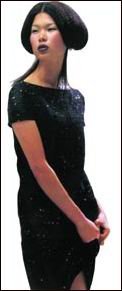The shortage of fashion models in China is being met by a flood of young women seeking to take off from the catwalk into a glamorous new career.
Living in a sleepy town in Hunan Province wasn't going to help 15-year-old Liu Shubei to realize her dream of becoming a fashion model.
But, as luck would have it, she still has a chance to make it, thanks to the boom in modeling competitions around the country.
Coverage of various modeling contests is splashed across the mass media and the spectacle of pretty faces and leggy figures is now a hot fixture on television.
Just in Shanghai recently, two major modeling contests have taken place -- Clairol Oriental Model Contest and Jeanswest China Model Contest -- with Elite Model Look 2004 International Shanghai on the way here on December 2.
Other parts of the country are also busy conducting modeling pageants. As extravagant as these contests may be, most of them are no longer designed to nurture the runway aspirations of young people.
The biggest winner may not be one of the genuine aspiring models but someone else. Take the story of Liu who took part in a modeling contest -- not her first -- last year.
She paid 800 yuan (US$96.80) to enter the national contest only to find out that the competition was rigged and the ultimate winner had been pre-arranged.
Like the rest of angry contestants, she backed out of the finals. Now she keeps her fingers crossed that the next contest she enters is fair and square.
Wang Yiqun, professor of modeling at Donghua University, says scandals of crooked modeling or beauty contests are rampant today and the judging criteria of some contests are questionable.

"An organizer of a top modeling contest in Beijing called me several days ago and said that my students can directly enter the finals if they are willing to pay 20,000 yuan," says Wang who has been in the modeling business for 20 years.
Once under-appreciated and considered to be an "indecent" job because of social bias, modeling has now become a highly sought-after career.
That keeps Wang on the go. Apart from teaching students and offering consulting and training services for some model agencies, she has been appointed as judge for four modeling contests this month, including the CCTV National Model Competition.
"A money machine has been well-established for such contests," she says. "Sponsors and advertisers have benefited enormously from the frequent media exposure."
Many of the sponsors are beauty or fashion products manufacturers who are eager to tap China's huge market.
Elite Model Look 2004 International Shanghai, sponsored by skincare brand OLAY, will have a live broadcast through major networks in more than 110 countries.
Besides the television broadcast, the industry has created a number of related activities to attract the eyes of viewers, ranging from fund-raising charities to commercial promotions.
The number of eyeballs watching means business and is well understood by shrewd business people. Pauly P.Y. Fung, director of Advertising and Promotion Department of Jeanswest International (HK) Ltd, admits that self-titled model contest will get wide publicity and enhance the brand image among young consumers.
Except for national modeling contests, more and more international-level events have also been introduced to China, such as the Elite Model Look International.
Tilted-up noses and a colorful spectacle are needed to show how "international" these contests are, even though the contestants are not qualified as international models.
Every cloud has a silver lining. Shen Zhiwen, vice dean of Paris Mod'art International Institute of Fashion and Arts at Shanghai University, says: "Through these events, we hope garment producers and designers will pay more attention to the fast-growing industry in this country.
"China is the world's largest garment manufacturing and consumption country. There are more than 50,000 garment companies but only about 10,000 professional models.

It is a big gap. Contests are still a major launching pad for young models, he says. Lin Jianfang, creative director for Clairol Oriental Model Contest, says that with more international contests held in China, the enterprises and organizers behind them will have a good chance to learn more about international rules and to improve their operations.
Professor Wang emphasizes that the winner's crown doesn't guarantee that the model wearing it is on the path to becoming a supermodel.
"If you don't hone your catwalk skills and improve yourself, people will forget you and your clients will ditch you," she says. "But if you're working very hard and have talent even though you didn't win a prize, you'll come out on top and get recognition from fashion companies."
The view is echoed by Wang Wenqin, a Shanghai supermodel who graces the covers of most major fashion magazines and has strutted the runway for big fashion houses in the Fashion Weeks of Paris and Milan. "It's just an ephemeral glamour when you win a prize," she says. "What counts most is how much you are wanted by people."
(Shanghai Daily December 1, 2004)

